The convenience and comfort of a private home attracts more and more people. The desire to experience the pleasure of peace and well-being does not disappear even after realizing the degree of responsibility for a new home.
After all, absolutely all life support systems fall on the owner. Including water supply. In order for the plumbing to work smoothly, it is necessary to take care of its competent laying. Of great importance is the choice of pipes for underground water supply.
![]()
The sources of underground water supply can be a well or an artesian well. The well is inferior in terms of water purity, but this option is more affordable. Drilling a well is not a cheap pleasure.
After the pumping equipment is selected. The main criterion is power. The more water is needed for a private house, the higher its capacity should be. Surface pumps are designed for depths up to 10 meters. Submersible units - up to 20 meters.
Criteria for choosing pipes for laying underground water supply
Pipes for underground water supply at the site are selected depending on the purpose. To work exclusively in the warm season, the products can be installed close to the ground surface. If year-round use of the water supply is expected, then installation must be carried out below the freezing line.
Pros and cons of different types of pipes
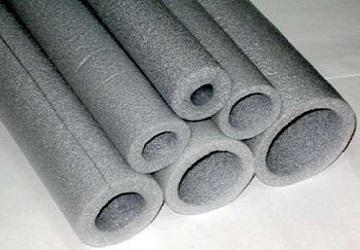
The range of models for underground water supply is quite wide. In particular, they can be made from various materials. And each of them has its positive and negative sides.
The choice of material is made depending on the amount that the owner has.
You also need to analyze your own needs and compare the parameters of each type of raw material.
Steel
Popular in the past, steel products have sunk into oblivion today. The demand for steel models has practically disappeared. This is explained trivially. This raw material for the manufacture plumbing structures morally obsolete. Much more durable and practical materials are used for the production of products.
To the advantage steel models can only be attributed to their small price. There are many more disadvantages:
- Expensive installation.
- Susceptibility to corrosion. Rust eventually fills the internal space of the product, the throughput decreases, the water pressure becomes weak.
- Steel is heavy. This can make installation difficult, it is difficult to carry it out alone.
metal-plastic
Modern material that meets all requirements. It is gaining more and more popularity every year. All thanks to the mass of positive aspects:
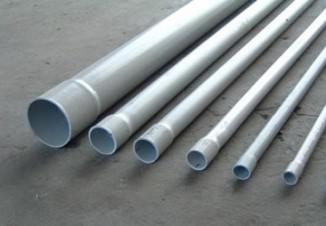
- Service life reaches 30-40 years. Metal-plastic is inferior in durability only copper products. But its performance is acceptable for modern construction.
- Affordable price range. The cost of these products is an order of magnitude lower than the price of copper pipes.
- Easy and simple installation. In order to carry out the installation, you do not need to have special knowledge. Metal-plastic pipes They are light in weight, so one person can handle the installation.
- Durability, reliability. Pipes for underground water supply, made of metal-plastic, are practical to use.
Products are made from several types of raw materials: glue, plastic and aluminum.
The manufacturing scheme is as follows: the aluminum frame is covered with plastic outside and inside, the structure is fastened with glue.
Plastic
Most cheap way to organize country water supply - to lay plastic pipes. Other numerous benefits include:
- Plumbing is easy and fast.
- The very low weight of the products allows installation alone.
- The service life reaches thirty years.
- Do not change the color, taste and smell of water.
- Not afraid of long exposure to sunlight.
- Do not rot.
- Do not crack or burst, even if there is ice inside.
- Water freezes in plastic pipes much less frequently than in other types of products.
- democratic value.
If it is decided to use plastic for plumbing, then you need to think about optimal thermal insulation and choose the right size. To do this, you can use the services of a specialist in this field. Repair work, modifications and installation of additional accessories can be done independently.
Copper
This option is the most costly of all. Nevertheless, copper models have several advantages:
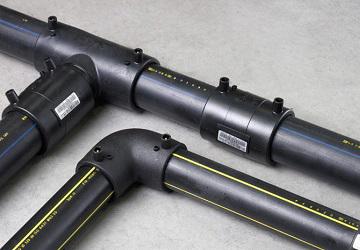
- Durability. Copper is different long term services. Pipes from this raw material are operated from fifty years to one and a half centuries.
- No corrosion. Copper pipes are not covered with rust. Due to this, the product lasts longer.
- disinfectant action. The bactericidal properties of copper have a positive effect on the quality of the passed water, which compensates for the high price.
After choosing the material for the pipes, you need to decide on their diameter.
Cost calculation
Cost of plumbing work suburban area or for a private house depends on several factors:
- length;
- number of pipes;
- installation method.
The trenchless method will cost the owner an average of $ 30 per one running meter. The most commonly used models with a diameter of 3-5 centimeters. In this case, the water flow rate will be approximately 2 m/s. Smaller diameter will result in water stagnation and rust formation on the internal surfaces products.
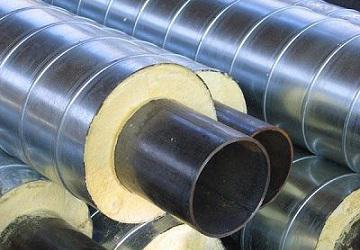
The cost of a pipe is directly related to its diameter. The larger it is, the more expensive the equipment. Installation of pipes with a diameter of 4 centimeters costs $ 80 per linear meter.
Trench laying of water supply has a much lower price than the trenchless method. A trench measuring 30 centimeters is dug for 10-15 dollars per one weather meter. A large trench requires a lot of money. Installation of a complex water branch at a depth of one or two meters is carried out for 40-50 dollars per linear meter.
The finished water supply system must be tested within one day, this is how the throughput of pipes is estimated. In the absence of problems, heat and waterproofing is installed on the pipes. If a marriage is detected, it is corrected through small hatches.
The correct choice of model affects the durability and reliability of the entire structure. The most practical and convenient to use are constructions made of plastic and metal-plastic.
You always have to pay some price to live in your own house enjoying peace and quiet, and working on the improvement of your home. Now the conversation is about different systems providing life comfort and responsibility of their organizer and owner. If you live in apartment building, then the public utilities will do everything for you, but if you have a private household, then be kind, answer for everything yourself. A typical example would be a plumbing system. What is its efficiency and function in different climates? The answer to this question is very simple, everything will be fine if it is laid in the ground correctly and according to the rules. How to properly produce and install an autonomous water supply system in a private household? That is exactly what we will talk about in our article.
The first beginnings in laying work
First things first, always create a layout plan first, the so-called blueprint. This will certainly not be the creation of the greatest architect with the inherent style and correctness of the image. But, nevertheless, the most important data should be present there, and first of all, you need to pay attention to the following.
- Laying a water pipe in the ground directly depends on the type of soil in the area, whether it is loose or soft.
- The total size of the entire area on which the pipe for the water supply will be laid, it is he who makes it clear what the approximate number of “entrance holes” and forks will be.
Important! Before you lay the water supply, you must.
Pipes, what material is best to use?
How deep to bury pipes? This is a constantly burning question that constantly hangs in the air and minds of people who want to do everything with their own hands. The correct conclusions should be drawn, first of all, by correctly determining the type of pipe. It is them individual characteristics and the qualities are completely unique when the water pipe is laid in the ground. The skills accumulated over time show that the best way out will be the HDPE PN10 pipe. If you say plain language then this is a material consisting of polyethylene, and low pressure, which is quite suitable for laying pipes through which drinking water will go.
Those. Characteristics of this type of pipe.
- Not exposed different kind corrosion, unlike metal.
- Hold pressure about 10 atmospheres.
- Very durable and unique.
- Very simple and easy to bend in different directions.
- During the winter period, they behave quite predictably and withstand everything very well.
Soil structuring directly affects the quality of the ditch.
Attention! There are pipes of the brand "PN 6" they are certainly more economical, but do not waste your nerves by buying a cheaper product, because during use there will definitely be nuances and problems.
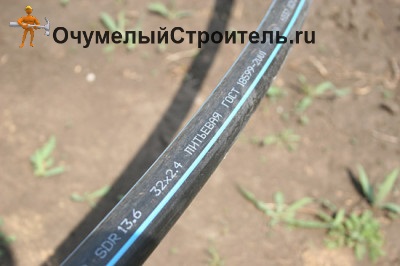
Special pipe for laying water supply in the ground
In addition, pipes of the first type "HDPE" are installed very quickly, and their fittings are not so expensive. We do not ask you to make a certain plumbing directly according to our article, you can consider and read any option yourself, everything will be the way you decide for yourself, and what means and opportunities you will have for this.
Laying a water pipe in the ground price: The average cost of laying 1 m / n water pipe from HDPE pipes DN 50mm open way- 2000 rubles / 520 hryvnias / 60 dollars.
Definitions of normative documents
So, first of all, we turn to SNiP, so that once again do not think about how deep the water pipe should be. This documentation defines, first of all, any technical nuance, up to the depth of the ditch for laying street pipes conducting water. In view of the developed regulatory legal acts, the depth of the pipes should be at least one and a half meters. Moreover, this instruction is justified:
- Most often, the ground freezes up to 1.4 meters, and if you make a ditch less than 1.6 m, this can lead to freezing of water in the pipe and the inability to use the water supply purely physically almost all winter until the thaw.
- How your area freezes depends on your location. It is better to consult in some construction company in your city. They usually dig in the ground all year round, and it is precisely in view of this that everyone will be able to explain to you exactly what the depth of freezing is, and what is better to do.
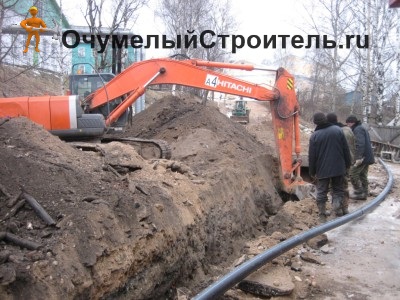
Attention. At a level deeper than 1.6 meters, the temperature is stable.
Some problems and nuances during the laying of plumbing into the ground
Usually the biggest troubles occur when the soil structure cannot allow you to go deep enough. What are we doing? We pull everything to the maximum, as much as possible. Next we lay the pipes, but before that we do good thermal insulation. Yes, and ultimately important aspect which is mandatory for the normal and proper functioning of the water supply system is the installation of heating cables along the entire length of the pipeline system. Of course, this version is very, very economically expensive thing, and it takes a lot of strength during installation. But in the end it's the most the best option, under given conditions.
Modern communications are laying different ways. Cables and pipes in houses are placed directly on the walls or behind them, sometimes water pipes have to be buried. Outside the house, deep pipe laying methods are mainly used, this is when a trench is used for plumbing.
It is almost impossible to damage properly laid water or sewer pipes underground, which makes this method of installing polyethylene communications extremely profitable and convenient.
Features of laying pipes in the ground
It is possible to lay a sewage pipeline made of polypropylene in the ground almost everywhere. And there are many reasons for this. To understand them, you need to soberly assess the situation and the features of laying pipelines.
Most modern buildings are connected to central heating and plumbing systems. Thus, the owners of these houses do not have to worry about installing and maintaining additional equipment such as pumping stations or building some kind of boiler house.
You just need to find and connect to the central highways, and then enjoy the gifts of civilization. However, to connect the house to the HDPE pipeline, you need to stretch the pipes to the building itself. It is possible to pull a water pipe along the ground if the depth of the water pipe is known, but such actions have certain consequences.
Ground laying of pipelines provides for the installation of pipes on consoles and special stands, it is not necessary to bury it. At the same time, the HDPE pipe is very easy to find and damage, it can freeze in winter or be damaged by atmospheric influences.
The visual side of the issue should also not be written off. It is unlikely that anyone will like it when their yard is cut through by multiple lines of pipelines, which will not decorate or improve the yard area at all.
And here it is worthwhile to understand that in addition to the work on connecting to the sewerage mains, it is also necessary to lay a fire water pipeline, household water supply systems for domestic irrigation, etc. on the site.
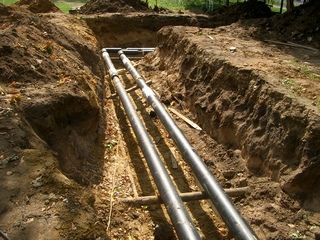
But it is better to bury water pipes in the ground, this saves us from all these problems. Pipes for HDPE water supply, which are laid underground, are extremely difficult to damage. Especially if they were properly laid and insulated from freezing. They do not prevent us from moving freely around the site for a meter and do not spoil its visual appearance.
The ability to hide the water supply underground is the right and most profitable solution for those who are faced with the issue of arranging communications or sewerage for their home.
The laying of water pipes in the ground is carried out at a certain depth. This is a very important procedure that cannot be ignored. At what depth it is better to bury the sewage pipelines of the PND depends on the characteristics of a particular region and the site itself.
What are the main tasks correct selection the depth of the pnd sewage pipelines is the exclusion of their possible freezing in winter time of the year. Each region has its own level of soil freezing. As a rule, this figure is 1.2-1.6 meters.
It follows from it that at maximum frost in this region, the earth will freeze to the specified meter. And it does not matter whether you use a trench or trenchless pipeline. In any case, the pnd sewer pipe must not be allowed to be above the freezing point of the soil. Otherwise, it will freeze with all the contents.
It is desirable that the product for water supply or sewerage in the ground has insulation, and is also at least 20 centimeters below the freezing point of the soil. With weak and loose soils, this figure doubles.
Insulation of pipes during installation
Laying the water pipe underground at the correct depth helps to get rid of most of the problems that are associated with freezing the soil and exposing it to low temperatures per meter. However, one should not forget about the insulation of the pipe for the water supply in the ground.
Here, the quality of the pipeline per meter and their properties also play a role. Always remember that pipelines laid in the ground are very difficult to get or find.
It is necessary to choose a material that is able to constantly withstand severe loads, be durable and have a low cost. Otherwise from permanent repair work and various kinds of minor troubles you can’t get rid of, and this has a considerable cost.
Here are a few basic requirements that apply if you want to use pipelines for underground installation:
- Resistance to external influences;
- Durability;
- Strength per meter of product;
- Lack of response to temperature changes;
- Efficiency of use underground;
- Easy to install, easy to insulate.
After many years of testing, it has been proven that the best pipes to use for pp water pipes are plastic samples. Specifically from polypropylene, polyvinyl chloride or low-density polyethylene. These pipes are durable, they need to be insulated, they do not react to corrosion at all and are very easy to use.
Certain requirements are also put forward for insulation, which largely intersect with similar requirements for pipes.
Here is the main list:
- Durability;
- Resistance to moisture per meter of product;
- Relative strength;
- No problems with rodents;
- Efficiency.
IN Lately insulation of water pipelines in the ground has to be used through the use of polyurethane foam insulation or highly compacted foam.
Methods for insulating underground pipelines
There are several ways to insulate a meter of a water pipe by digging underground. Each of them provides for the possibility of using different materials and designs.
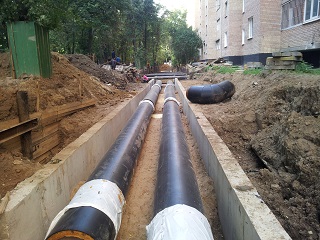
Here we list some of the main most popular ways:
- The underground water pipe is additionally wrapped with polyurethane foam insulation or other similar material, the width of which may be different;
- When digging, pipelines are poured with polystyrene concrete or peto concrete, forming a kind of protective cover from lightweight concrete;
- Laying a water pipe in a case, when the main pipeline is inside another, larger pipe and a thermal air gap is formed between them. Methods for trenchless laying of pipelines provide for the possibility of insulating products using such a system;
- Winding the pipe with a heating cable, the width of which is selected individually;
- Increasing pressure in the pipeline. This method of insulation is not so in demand, since the pressure can be increased to high levels only in individual systems. But scientists have proven that high pressure the liquid in the pipes does not freeze and builders use this feature.
Technology and stages for laying pipes underground
Earthworks during the laying of pipelines are carried out in two main ways: trench or trenchless. Each of them has its own characteristics and is applicable in different situations.
Trench pipe laying
Laying water pipes in the ground in trenches is the oldest and simplest method for performing such work. The task of the builders is to dig a trench and lay a pipeline along it in the right direction. With this method, it is easy to find the laid pipelines.
You can even dig trenches by hand. However, one cannot ignore the fact that this is hard and lengthy work. The use of construction equipment greatly simplifies the work of diggers, but does not reduce its cost in any way. It is enough just to remember or find the cost of one hour of work of an excavator, and you will need a lot of such hours.
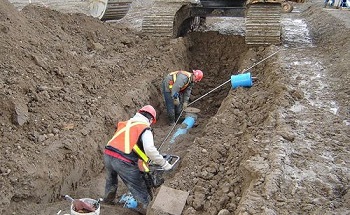
The width of the trench with a deep laying of the water supply system is 70-90 centimeters. Here, the number of pipelines being laid, as well as their dimensions, have an influence. The depth of the trench, as mentioned above, is selected by determining the freezing point of the soil (you can find it in special tables).
- We dig a trench of the required size.
- We seal the walls and bottom of the trench.
- We make a shock-absorbing pillow from 10 cm of sand.
- We are engaged in laying and connecting pipelines.
- We fill the pipes with sand to a level that should be found 5 cm above the top point of the largest pipeline.
- We lay the places where the pipes pass in one layer broken brick, shingles or tiles.
- We stretch a red plastic tape from above.
- We fill the trench with earth.
Trenchless pipe laying
Methods of trenchless laying of pipelines have appeared relatively recently. The fact is that channelless laying of pipelines is possible only through the use of a variety of specialized equipment. To work, you need to find hydraulic jack, laser level, etc.
Trenchless laying is carried out with the help of sanitation or piercing. Sanitation is a replacement old pipe or the introduction of a new one. If the old pipes are preserved, then the new pipeline is simply passed through them.
Piercing consists in finishing the laying of the pipe. A special device independently digs a place under the pipe, and then simultaneously fixes it by mounting the steel shell. Then the pipeline is placed directly inside the shell itself. This method of installation is also called a gasket in a case.
- We accurately determine the lines of the future pipeline and dig two pits at its opposite ends.
- Determine direction with laser level or theodolite and install drilling equipment.
- We are waiting for the device to finish its work.
- After completing the formation of the case, we push the pipes into it.
- We connect the pipeline to the system, then we test it for operability.
Trenchless laying (video)
Price of work
The price of laying a water pipe in the ground depends on its length, volume and the way the work is done.
The cost of laying a water pipe in the ground using a trenchless method is 25-35 dollars per 1 meter. This takes into account the fact that the pipe being laid has a diameter in the range of 100-120 mm. The thicker the pipe, the more you have to pay. Laying pipes with a diameter of 400 mm will already cost 75-90 dollars per 1 linear meter.
The cost of trenching is much less. With a trench width of 30 cm, it can be ordered for $ 10 1 m. However, the larger the trench, the more you will have to pay for it. Installation of pipelines with several branches and at a depth of 1.5 meters is estimated from $ 40 per 1 m.
pave water pipe underground is much more economical than the insulation of the ground line. But it is worth knowing that under the ground, careful insulation of the water pipe is also required. The installation of such a line can begin in any direction: internal wiring - an introductory tap or, conversely, from the tap to the house. Most often, the inlet tap is located in a special well, which is located on the territory of a private household. It can be a metal or polypropylene faucet.
The first step in laying a water pipe is to dig a trench to the desired depth. Then, a hole is made in the wall of the well from the trench with a diameter equal to the pipe plus insulation. From the side of the trench, a pre-welded and insulated pipe is launched into the well.
In the event that it is planned to install a water meter in the house, if you want to mount a street column in the yard, you will have to pull an additional pipe from the house to the yard. If the water meter assembly is installed in the well, then you can immediately bring the gander up. It will also be useful for construction works and will be useful in the future, for domestic purposes.
To do this, you just need to solder a suitable tee, doing it “later” will be much more problematic. The mistake of many is to bring such a column straight up through the lid that closes the well. It is much easier for water to get inside from top to bottom. It is much better to run the pipe through the same wall as the main line. To do this, a hole is drilled exactly above the place where the tee will be soldered.
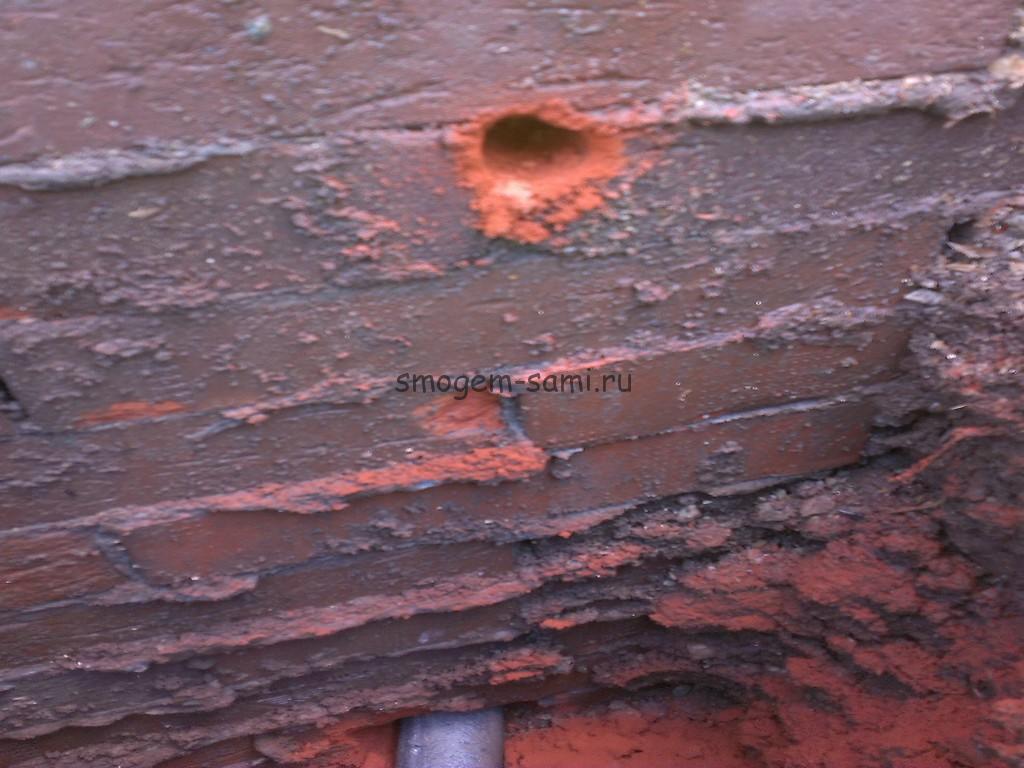 Under the hole, the rest of the connections are made.
Under the hole, the rest of the connections are made.
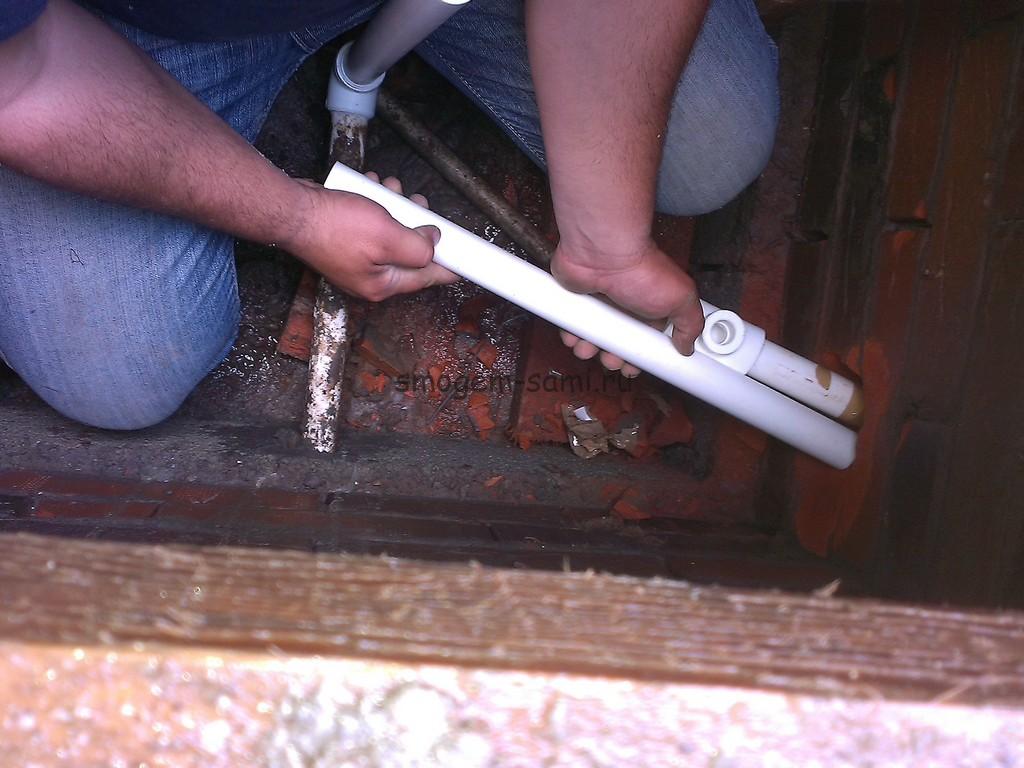 The design must comply with the condition: a site is needed on which a water meter will be installed, and this site must be in front of all possible taps. This is how the connection in the well looks like:
The design must comply with the condition: a site is needed on which a water meter will be installed, and this site must be in front of all possible taps. This is how the connection in the well looks like:
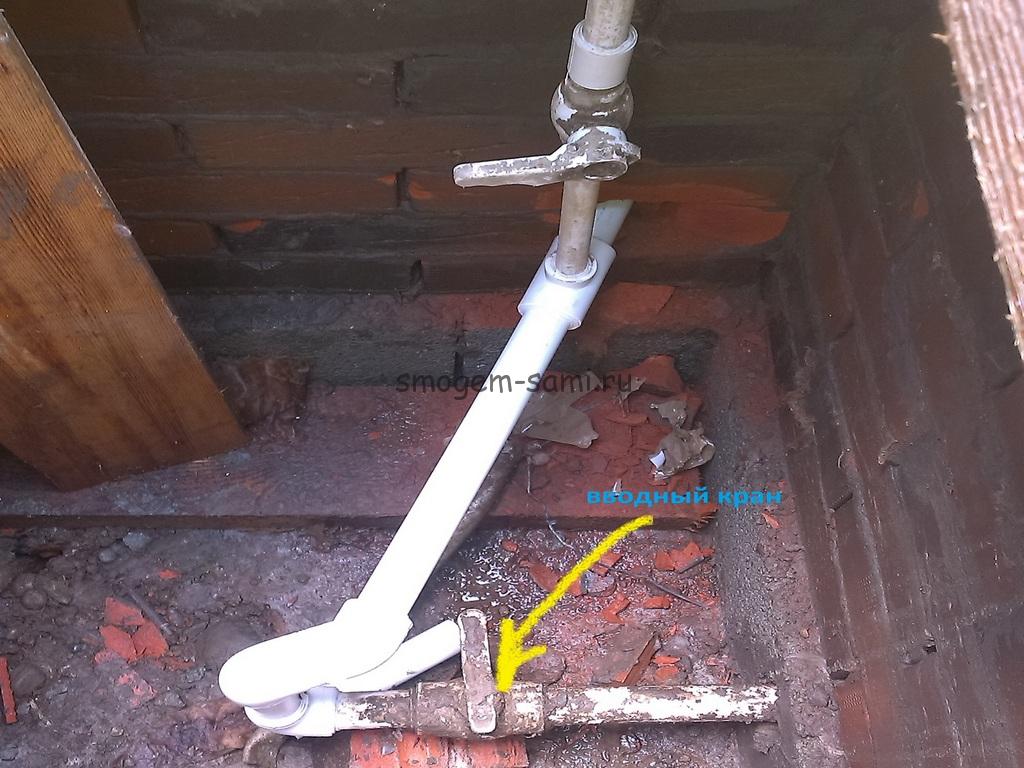 Here the water meter will be installed on a horizontal section.
Here the water meter will be installed on a horizontal section.
The water supply must enter the building at the same depth. Up the pipe rises already inside the house.
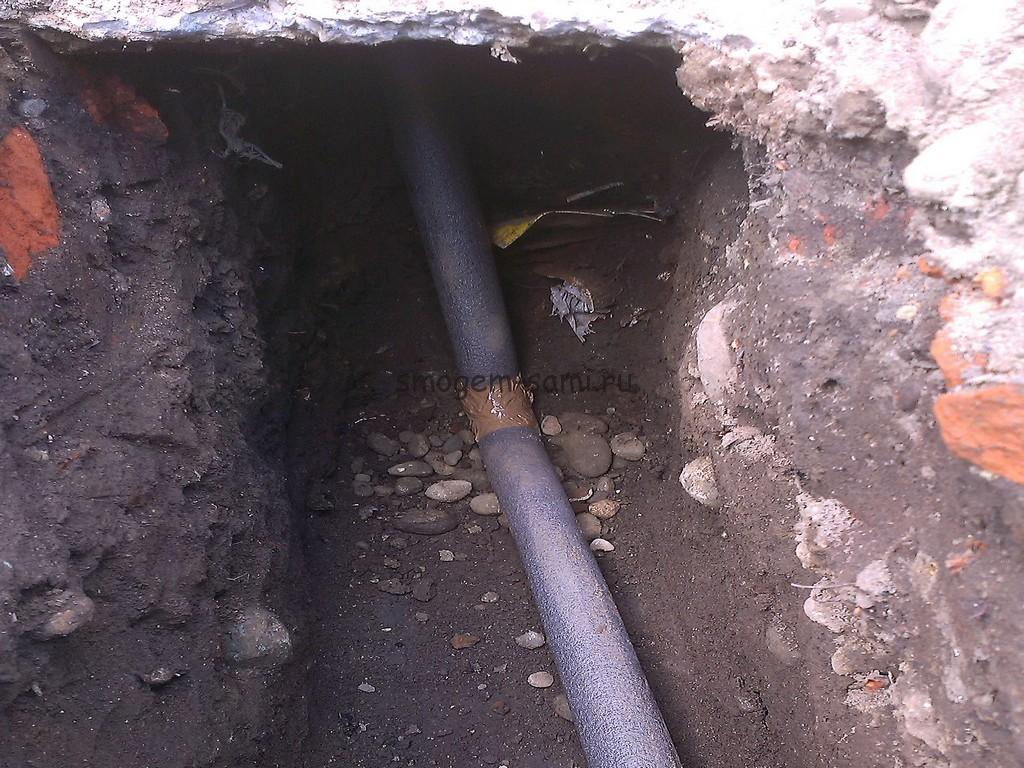 After the line is started, all street work can be completed. The weather may change and the trench, in case of rain, may fill with water, which is not good. The pipe, previously insulated, is first covered with sand.
After the line is started, all street work can be completed. The weather may change and the trench, in case of rain, may fill with water, which is not good. The pipe, previously insulated, is first covered with sand.
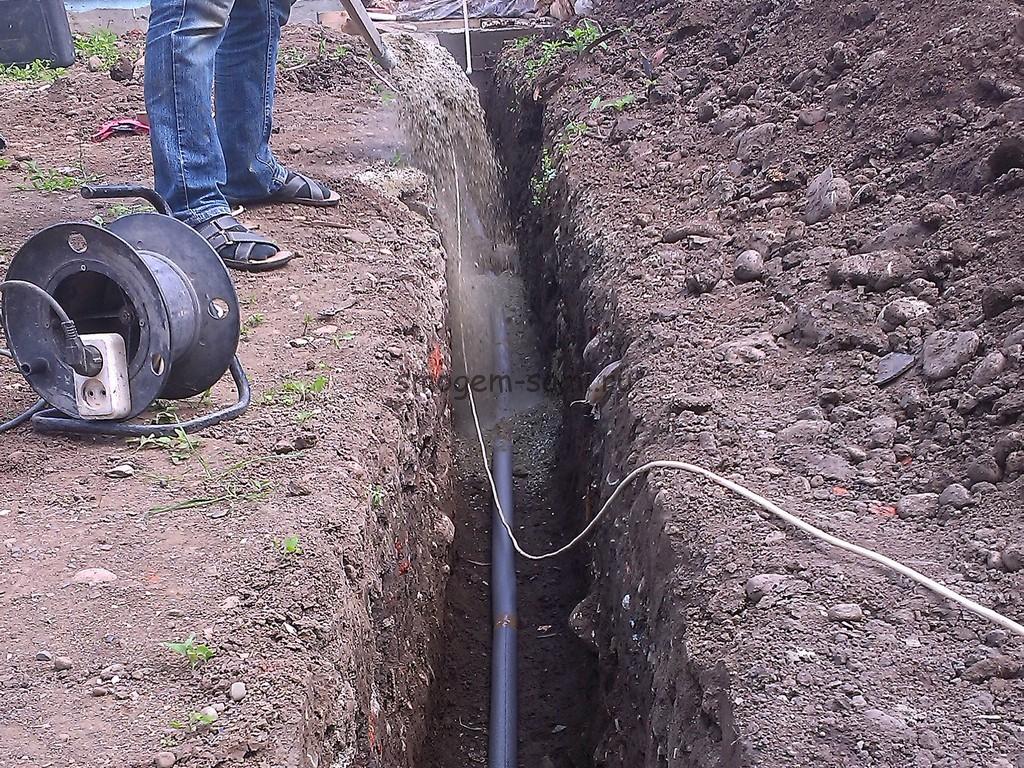 It falls asleep until a layer of sand of 5-10 cm hides the insulation.
It falls asleep until a layer of sand of 5-10 cm hides the insulation.
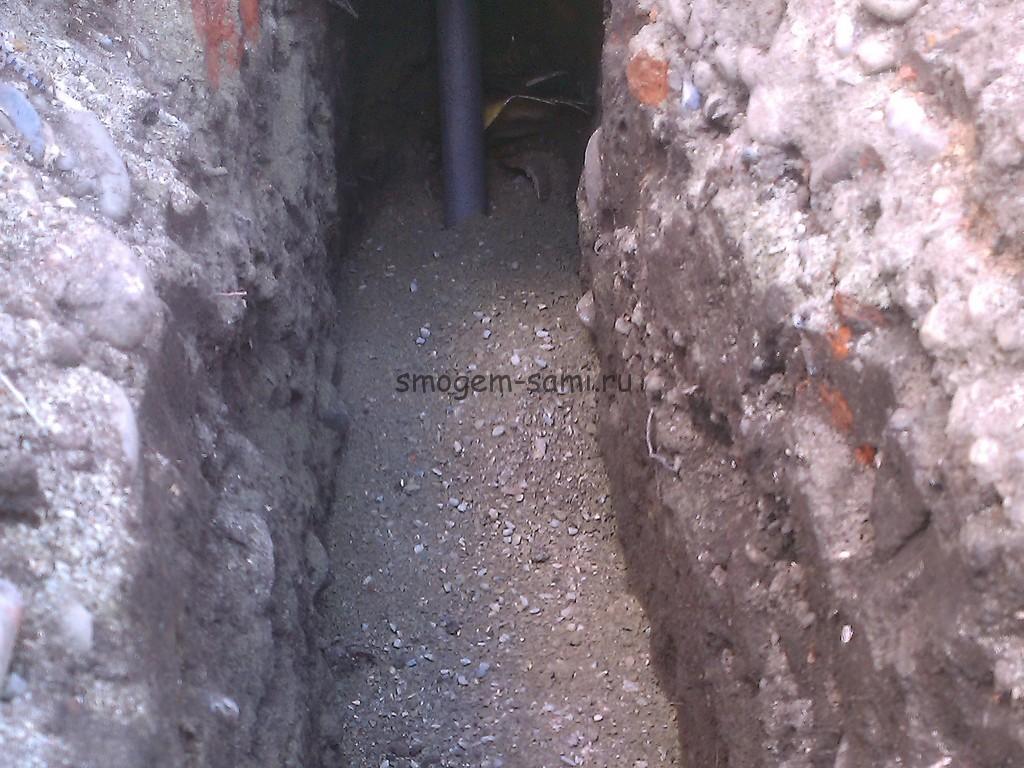 Inside the house, the pipe must lie so that it is not damaged during construction work. If for this you need to dig a small depression, it is better to do it. Having entered the building in the trench, the line continues its way to the place where all the wiring will begin.
Inside the house, the pipe must lie so that it is not damaged during construction work. If for this you need to dig a small depression, it is better to do it. Having entered the building in the trench, the line continues its way to the place where all the wiring will begin.
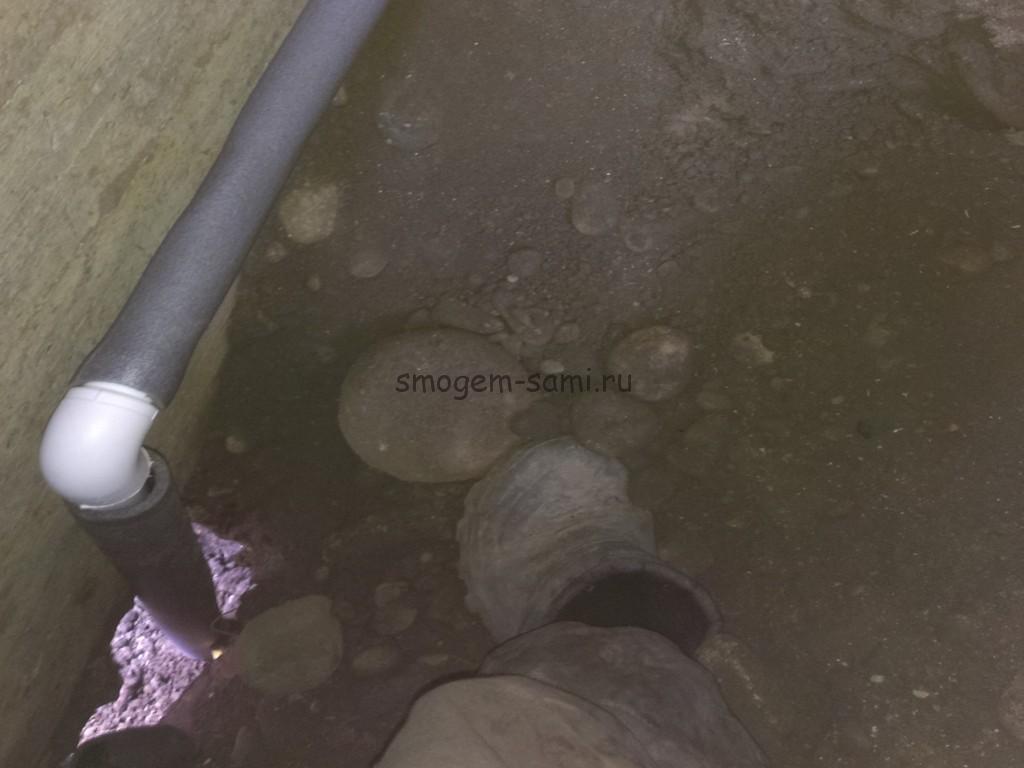 At this point, you need to install another introductory crane, which in the future will be the main, working crane. For convenience, after the crane, you can bring out another gander, for the duration of the internal work.
At this point, you need to install another introductory crane, which in the future will be the main, working crane. For convenience, after the crane, you can bring out another gander, for the duration of the internal work.
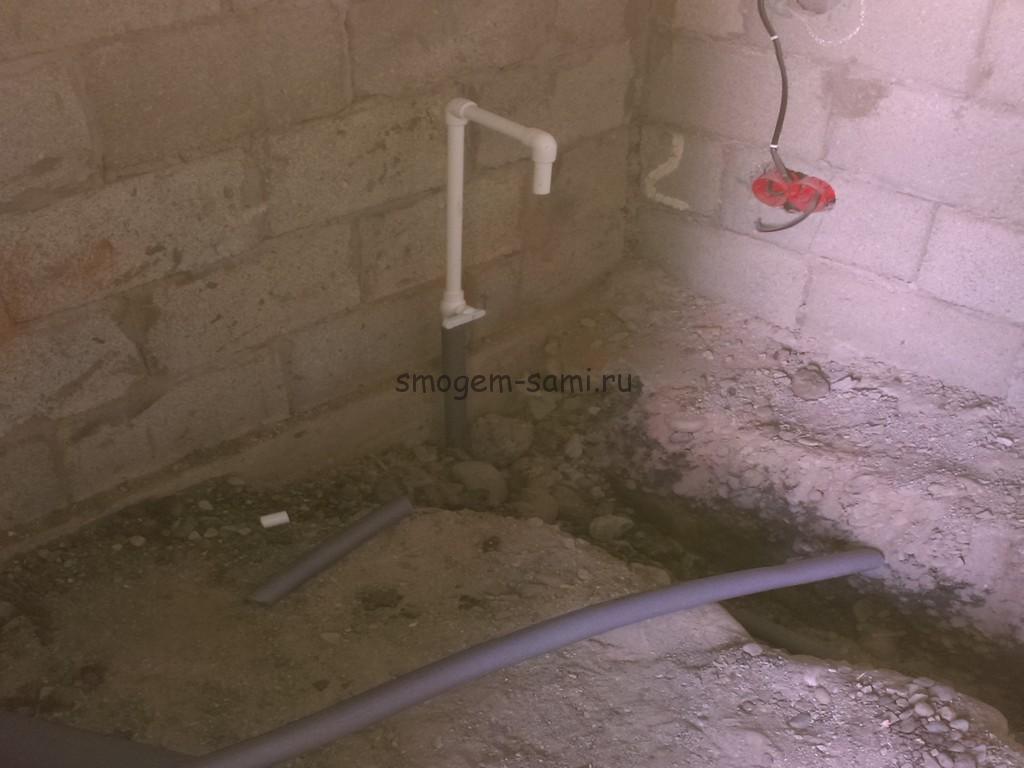 It is also better to place the pipe inside the building in a heater. Inside it, the temperature will remain more uniform, which will serve as protection against condensation.
It is also better to place the pipe inside the building in a heater. Inside it, the temperature will remain more uniform, which will serve as protection against condensation.
In places where the pipe turns, you need to try to take into account one small, but important detail: where possible, instead of one 90° corner, it is better to install two 45° corners. This will reduce water resistance, and keep the diameter of the main line up to the very opening faucet in the house.
If during the installation of the water line there is no need to solder the rotary corners, it is better not to do this.
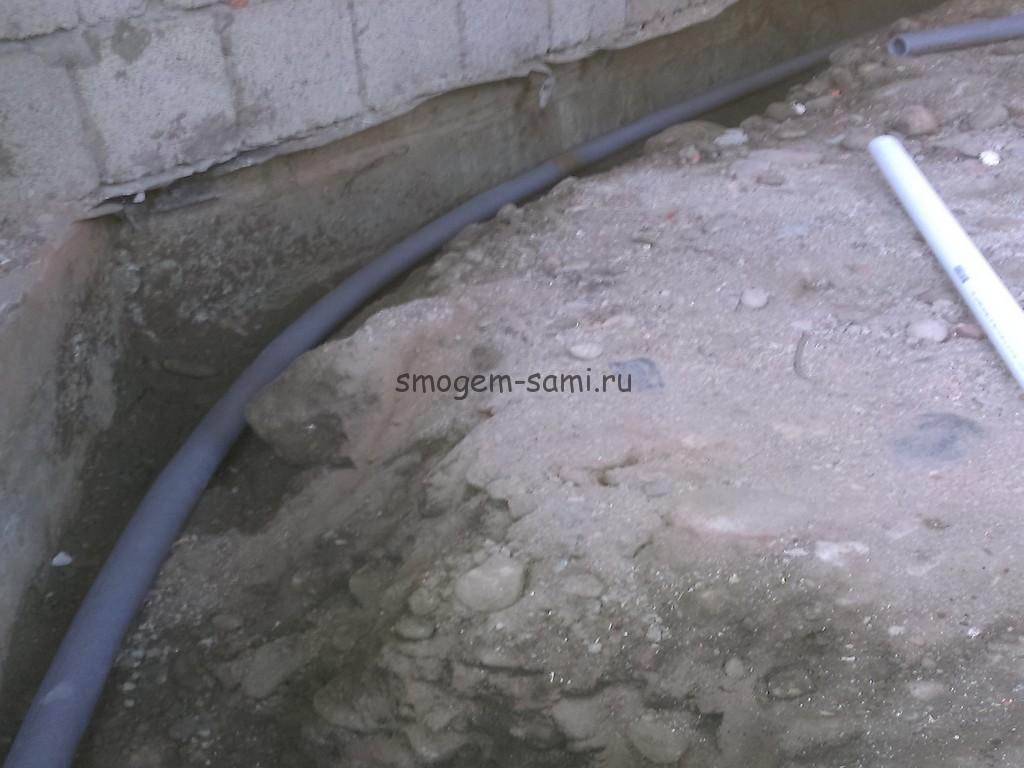 After the line is installed, before backfilling, it is necessary to insulate all unclosed sections of the pipeline (more often these are the places of turns). You can fasten the insulation with tape.
After the line is installed, before backfilling, it is necessary to insulate all unclosed sections of the pipeline (more often these are the places of turns). You can fasten the insulation with tape.
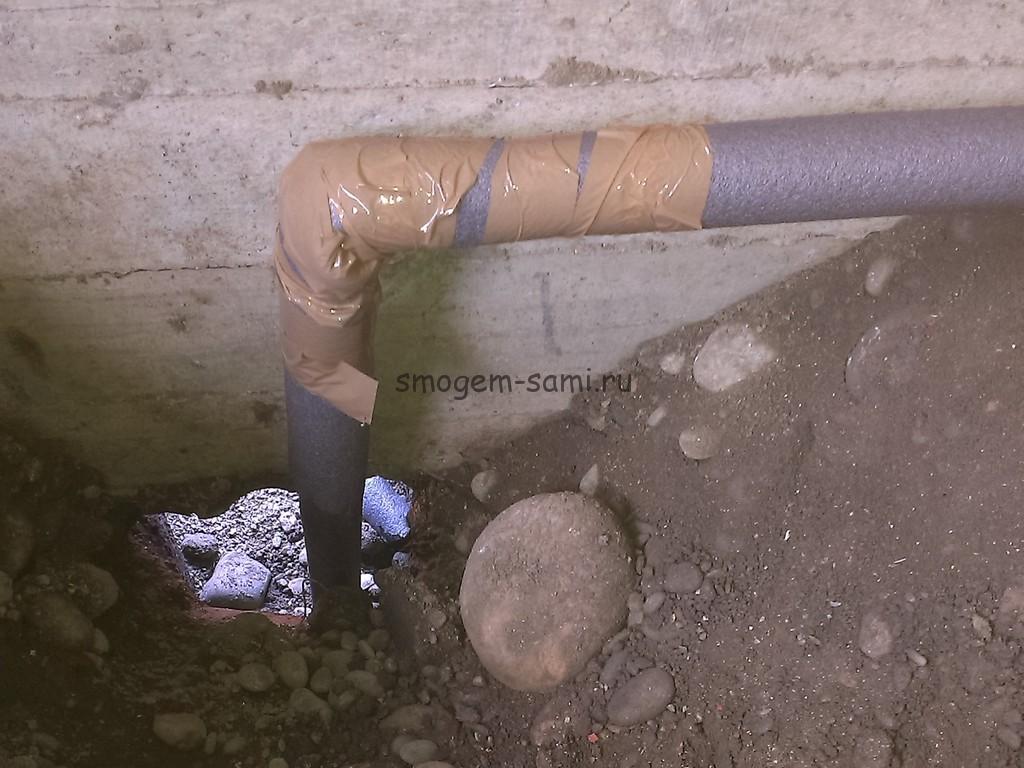
Laying a pipeline is a job that almost any owner of a summer house or country house. The fact is that ground installation of water supply or heating is allowed only in disadvantaged areas where the structure does not interfere with anyone or where it is not possible to place the system underground. In all other cases, underground installation is assumed.
How to lay a water pipe underground
The main problem in transferring liquids, especially hot ones, is heat loss during transfer. Because of this, underground laying is recommended: losses in the air will be much higher, while the ground conducts heat worse. In practice, this, of course, is not enough and the pipe must be laid in the ground with a heater.
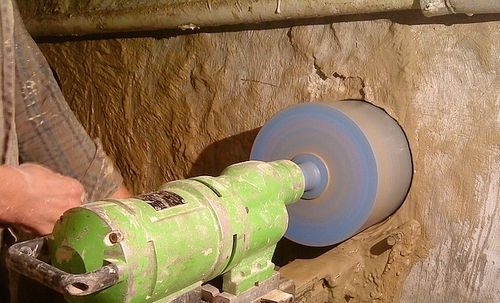
Quite familiar materials are used for this - basalt wool, polyethylene foam, polystyrene foam. The thickness of the thermal insulation layer is calculated taking into account the weather. In some cases, even the use of a heating cable is allowed.
Second mandatory requirement- determination of depth. The pipeline must be located below the freezing level of the soil. Otherwise, there is a high risk of water freezing and, consequently, damage to the system. For medium regions, the freezing level is about 1.4 m. The optimal depth for the plumbing system is 1.6 m. Great depth is not recommended, since the product may not withstand ground pressure, especially when it comes to HDPE conduits.
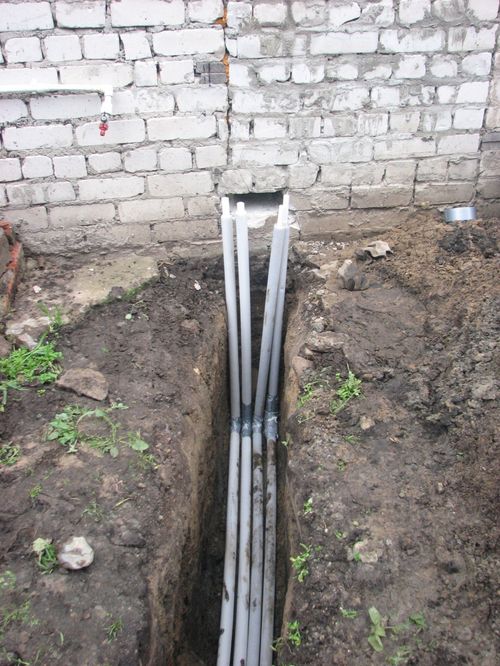
The pipeline is placed in the ground at a ready-made- assembled and insulated, so that all welding work must be completed before installation.
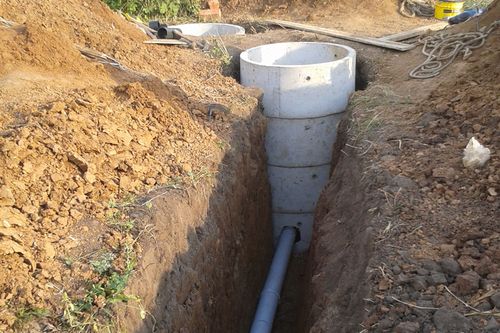
The very same technology for assembling a water pipe is simple, if the scheme is correctly calculated.
- According to the plan, they dig a trench to the desired depth. The width is small: for one HDPE conduit. for example, 40-50 cm is enough.
- Most often, in private construction, an introductory crane is installed in a well. Sometimes a water meter is installed in the same place. A hole is made in the wall of such a well, equal to the size of the conduit, and the assembled and heat-insulated pipeline is lowered into the well.
- If the counter is located in the well, then it would be right to immediately bring the gander up. The meter itself is mounted in front of all cranes.
- The plumbing enters the house at the same depth as it is placed in the trench. Mounting upwards is only permitted inside the building.
- The trench is covered with sand until a layer of sand 5–10 cm thick forms over the conduit. Then the trench is covered with soil.
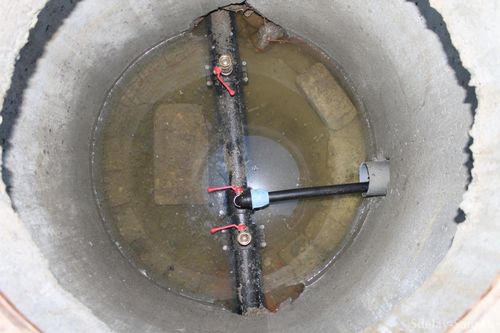
How to lay a water pipe underground, you can find out in detail from the video.
In cases where there is some kind of obstacle in front of the well - a road, for example, which is not uncommon in a summer cottage where more than one person uses the well, the question arises of how to lay a pipe underground without digging. Such technology exists, but in fact, in most cases, laying a trench is cheaper.
To lay the pipeline without digging, it is necessary to bring the usual trench to the obstacle. Then they equip the recess at the bottom of the trench and fix the support platform from the timber. The soil in the desired area is pierced with a 3-meter solid bar. The bar rests on the jack, the latter rests on the platform. This way you can pierce the area under the road without digging.
![]()
Laying the heating system
You can lay a heating pipe underground in the same way as a water pipe. But a few more requirements are added to the above requirements:
- placement is allowed heating pipes above freezing level. But in this case, the thermal insulation should be much better and protection against freezing of water is provided. Laying the system below the freezing level is always cheaper in the end;

- the return pipe should in no case be higher or at the same level as the supply pipe;
- it would be right to foresee additional protection from ground pressure, especially when there is a risk of movement or high groundwater.
Thermal insulation materials for heating conduits are the same. On the picture - heating system in a "shell" of expanded polystyrene.








